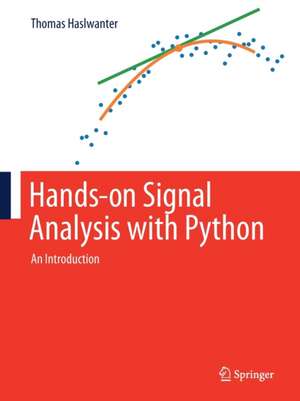Hands-on Signal Analysis with Python: An Introduction
Autor Thomas Haslwanteren Limba Engleză Paperback – 2 iun 2022
Preț: 400.53 lei
Nou
Puncte Express: 601
Preț estimativ în valută:
76.64€ • 81.96$ • 63.90£
76.64€ • 81.96$ • 63.90£
Carte disponibilă
Livrare economică 28 martie-11 aprilie
Livrare express 13-19 martie pentru 43.53 lei
Preluare comenzi: 021 569.72.76
Specificații
ISBN-13: 9783030579050
ISBN-10: 3030579050
Pagini: 267
Ilustrații: XVI, 267 p. 156 illus., 106 illus. in color.
Dimensiuni: 210 x 279 x 25 mm
Greutate: 0.64 kg
Ediția:1st ed. 2021
Editura: Springer International Publishing
Colecția Springer
Locul publicării:Cham, Switzerland
ISBN-10: 3030579050
Pagini: 267
Ilustrații: XVI, 267 p. 156 illus., 106 illus. in color.
Dimensiuni: 210 x 279 x 25 mm
Greutate: 0.64 kg
Ediția:1st ed. 2021
Editura: Springer International Publishing
Colecția Springer
Locul publicării:Cham, Switzerland
Cuprins
Introduction.- Python.- Data Input.- Data Display.- Data Filtering.- Event- and Feature-Finding.- Statistics.- Parameter Fitting.- Spectral Signal Analysis.- Solving Equations of Motion.- Machine Learning.- Useful Programming Tools.
Notă biografică
Thomas Haslwanter is a Professor at the Department of Medical Engineering of the University of Applied Sciences Upper Austria in Linz, and lecturer at the ETH Zurich in Switzerland. He also worked as a researcher at the University of Sydney, Australia and the University of Tuebingen, Germany. He has extensive experience in medical research, with a focus on the diagnosis and treatment of vertigo and dizziness and on rehabilitation. After 15 years of extensive use of Matlab, he discovered Python, which he now uses for statistical data analysis, sound and image processing, and for biological simulation applications. He has been teaching in an academic environment for more than 10 years.
Textul de pe ultima copertă
This book provides the tools for analyzing data in Python: different types of filters are introduced and explained, such as FIR-, IIR- and morphological filters, as well as their application to one- and two-dimensional data. The required mathematics are kept to a minimum, and numerous examples and working Python programs are included for a quick start. The goal of the book is to enable also novice users to choose appropriate methods and to complete real-world tasks such as differentiation, integration, and smoothing of time series, or simple edge detection in images. An introductory section provides help and tips for getting Python installed and configured on your computer. More advanced chapters provide a practical introduction to the Fourier transform and its applications such as sound processing, as well as to the solution of equations of motion with the Laplace transform. A brief excursion into machine learning shows the powerful tools that are available with Python. This book also provides tips for an efficient programming work flow: from the use of a debugger for finding mistakes, code-versioning with git to avoid the loss of working programs, to the construction of graphical user interfaces (GUIs) for the visualization of data. Working, well-documented Python solutions are included for all exercises, and IPython/Jupyter notebooks provide additional help to get people started and outlooks for the interested reader.
Caracteristici
Excellent, understandable and motivating textbook and a good starting point for the practical signal processing with Python Provides the readers with a toolbox that allows them to solve most practical tasks that come up in signal processing A hands-on Signal Analysis with Python
